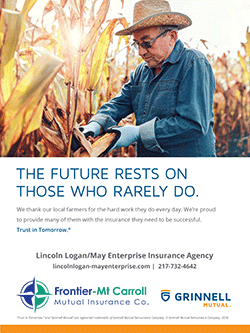|
 ARC provides income support payments on historical base acres
when actual crop revenue declines below a specified guaranteed
level. PLC provides income support payments on historical base
acres when the effective price for a covered commodity falls
below its reference price. The 2018 Farm Bill reauthorized and
updated both programs. ARC provides income support payments on historical base acres
when actual crop revenue declines below a specified guaranteed
level. PLC provides income support payments on historical base
acres when the effective price for a covered commodity falls
below its reference price. The 2018 Farm Bill reauthorized and
updated both programs.
Signup for the 2019 crop year closes March 15, 2020, while
signup for the 2020 crop year closes June 30, 2020. Producers
who have not yet enrolled for 2019 can enroll for both 2019 and
2020 during the same visit to an FSA county office.
ARC and PLC have options for the farm operator who is actively
farming the land as well as the owner of the land. Farm owners
also have a one-time opportunity to update PLC payment yields
beginning with crop year 2020. If the farm owner and producer
visit the FSA county office together, FSA can also update yield
information during that visit.
Covered commodities include barley, canola, large and small
chickpeas, corn, crambe, flaxseed, grain sorghum, lentils,
mustard seed, oats, peanuts, dry peas, rapeseed, long grain
rice, medium and short grain rice, safflower seed, seed cotton,
sesame, soybeans, sunflower seed and wheat.

More Information
For more information on ARC and PLC including two online
decision tools that assist producers in making enrollment and
election decisions specific to their operations, visit the ARC
and PLC webpage.
USDA Announces Opening Signup for
Conservation Reserve Program on December 9, 2019
USDA is opening signup for the Conservation Reserve Program
(CRP) on December 9, 2019. The deadline for agricultural
producers to sign up for general CRP is February 28, 2020, while
signup for continuous CRP is ongoing.
Farmers and ranchers who enroll in CRP receive a yearly rental
payment for voluntarily establishing long-term,
resource-conserving plant species, such as approved grasses or
trees (known as “covers”) to control soil erosion, improve water
quality and develop wildlife habitat on marginally productive
agricultural lands.
CRP has 22 million acres enrolled, but the 2018 Farm Bill lifted
the cap to 27 million acres. This means farmers and ranchers
have a chance to enroll in CRP for the first time or continue
their participation for another term.
By enrolling in CRP, producers are improving water quality,
reducing soil erosion, and restoring habitat for wildlife. This
in turn spurs hunting, fishing, recreation, tourism, and other
economic development across rural America.
CRP Rates and Payments
FSA recently posted updated soil rental rates for CRP. County
average rates are posted on the CRP Statistics webpage. Soil
rental rates are statutorily prorated at 90 percent for
continuous signup and 85 percent for general signup. The rental
rates will be assessed annually. Under continuous signup,
producers also receive incentives, including a signup incentive
payment and a practice incentive payment.
For CRP enrollment options or to enroll in CRP, contact your
local FSA county office or visit fsa.usda.gov/crp. To locate
your local FSA office, visit farmers.gov/service-locator.
Sign In Sign Up!
Farmers, ranchers and agricultural producers have new online
options to access U.S. Department of Agriculture (USDA)
programs. Through USDA’s new streamlined process, producers
doing business as an individual can now register, track and
manage their applications for the Market Facilitation Program (MFP)
on the secure and convenient www.farmers.gov. Producers doing
business as an individual first need to sign up for the Level 2
eAuthentication access. Currently USDA eAuthentication does not
have the mechanism to issue accounts to businesses,
corporations, other entities or for anyone acting on behalf of
another individual or entity.
Step 1: Create an online account at
www.eauth.usda.gov
Step 2: Complete identity verification by either using
the online self-service identity verification method or by
completing the identity verification in-person at your USDA
Service Center.

Step 3: You’re enrolled
Step 4: Contact your local USDA Service Center to have
your new Level 2 account linked with your USDA customer record
Step 5: You’re ready to Log in
Or go to your local USDA Service Center and our support staff
will help you sign up for Level 2 Access right in the office!
They will get you online so you can create an online account at
https://farmers.gov/sign-in. You’ll complete identity
verification right on the spot. You’re enrolled! Users with a
secure Level 2 eAuthentication ID linked to their USDA customer
record can apply for select USDA programs, view and print farm
maps and farm records data. Enrolling is easy! Visit farmers.gov/sign-in
to learn more.
To locate a service center near you or use online services not
requiring eAuthentication access, visit www.farmers.gov. For
technical assistance, call the eAuthentication help desk at
1-800-457-3642.
USDA Offers Targeted Farm Loan Funding for
Underserved Groups and Beginning Farmers
The USDA Farm Service Agency (FSA) reminds producers that FSA
offers targeted farm ownership and farm operating loans to
assist underserved applicants as well as beginning farmers and
ranchers.
USDA defines underserved applicants as a group whose members
have been subjected to racial, ethnic, or gender prejudice
because of their identity as members of the group without regard
to their individual qualities. For farm loan program purposes,
targeted underserved groups are women, African Americans,
American Indians and Alaskan Natives, Hispanics and Asians and
Pacific Islanders.
Underserved or beginning farmers and ranchers who cannot obtain
commercial credit from a bank can apply for either FSA direct
loans or guaranteed loans. Direct loans are made to applicants
by FSA. Guaranteed loans are made by lending institutions who
arrange for FSA to guarantee the loan. FSA can guarantee up to
95 percent of the loss of principal and interest on a loan. The
FSA guarantee allows lenders to make agricultural credit
available to producers who do not meet the lender's normal
underwriting criteria.
The direct and guaranteed loan program provides for two types of
loans: farm ownership loans and farm operating loans. In
addition to customary farm operating and ownership loans, FSA
now offers Microloans through the direct loan program. The focus
of Microloans is on the financing needs of small, beginning
farmer, niche and non-traditional farm operations. Microloans
are available for both ownership and operating finance needs. To
learn more about microloans, visit
www.fsa.
usda.gov/microloans.
To qualify as a beginning producer, the individual or entity
must meet the eligibility requirements outlined for direct or
guaranteed loans. Additionally, individuals and all entity
members must have operated a farm for less than 10 years.
Applicants must materially or substantially participate in the
operation.
For more information on FSA’s farm loan programs and targeted
underserved and beginning farmer guidelines, visit
www.fsa.usda.gov/farmloans.

Marketing Assistance Available for 2019
Crops
The 2018 Farm Bill extends loan authority through 2023 for
Marketing Assistance Loans (MALs) and Loan Deficiency Payments (LDPs).
MALs provide financing and marketing assistance for commodities
such as wheat, feed grains, soybeans and other oilseeds, pulse
crops, rice, wool and honey. MALs provide producers interim
financing after harvest to help them meet cash flow needs
without having to sell their commodities when market prices are
typically at harvest-time lows.
A producer who is eligible to obtain a MAL, but agrees to forgo
the loan, may obtain an LDP if such a payment is available.
To be eligible for a MAL, producers must have a beneficial
interest in the commodity, in addition to other requirements. A
producer retains beneficial interest when control of and title
to the commodity is maintained.
Farm Storage Facility Loans
FSA’s Farm Storage Facility Loan (FSFL) program provides
low-interest financing to producers to build or upgrade storage
facilities and to purchase portable (new or used) structures,
equipment and storage and handling trucks.
[to top of second column] |

The low-interest funds can be used to build or upgrade permanent
facilities to store commodities. Eligible commodities include corn,
grain sorghum, rice, soybeans, oats, peanuts, wheat, barley, minor
oilseeds harvested as whole grain, pulse crops (lentils, chickpeas
and dry peas), hay, honey, renewable biomass, fruits, nuts and
vegetables for cold storage facilities, floriculture, hops, maple
sap, rye, milk, cheese, butter, yogurt, meat and poultry
(unprocessed), eggs, and aquaculture (excluding systems that
maintain live animals through uptake and discharge of water).
Qualified facilities include grain bins, hay barns and cold storage
facilities for eligible commodities.
Loans up to $50,000 can be secured by a promissory
note/security agreement and loans between $50,000 and $100,000 may
require additional security. Loans exceeding $100,000 require
additional security.
Producers do not need to demonstrate the lack of commercial credit
availability to apply. The loans are designed to assist a diverse
range of farming operations, including small and mid-sized
businesses, new farmers, operations supplying local food and farmers
markets, non-traditional farm products, and underserved producers.
To learn more about the FSA Farm Storage Facility Loan, visit
www.fsa.
usda.gov/pricesupport or contact your local FSA county
office. To find your local FSA county office, visit
http://offices.usda.gov.
Double-Cropping
Each year, state committees will review and approve or disapprove
county committee recommended changes or additions to specific
combinations of crops.
Double-cropping is approved when the two specific crops have the
capability to be planted and carried to maturity for the intended
use, as reported by the producer, on the same acreage within a crop
year under normal growing conditions. The specific combination of
crops recommended by the county committee must be approved by the
state committee.
Double-cropping is approved in Illinois on a county-by-county basis.
Contact your local FSA Office for a list of approved double-cropping
combinations for your county.
A crop following a cover crop terminated according to termination
guidelines is approved double cropping and these combinations do not
have to be approved by the state committee.

Unauthorized Disposition of Grain
If loan grain has been disposed of through feeding, selling or any
other form of disposal without prior written authorization from the
county office staff, it is considered unauthorized disposition. The
financial penalties for unauthorized dispositions are severe and a
producer’s name will be placed on a loan violation list for a
two-year period. Always call before you haul any grain under loan.
USDA Offers Disaster Assistance for Illinois
Farmers Hurt by 2018, 2019 Disasters
Agricultural producers affected by natural disasters in 2018 and
2019 can apply through the Wildfire and Hurricane Indemnity Program
Plus (WHIP+). Sign-up for this U.S. Department of Agriculture (USDA)
program began Sept. 11.
WHIP+ Eligibility
WHIP+ will be available for eligible producers who have suffered
eligible losses of certain crops, trees, bushes or vines in counties
with a Presidential Emergency Disaster Declaration or a Secretarial
Disaster Designation (primary counties only). Disaster losses must
have been a result of hurricanes, floods, tornadoes, typhoons,
volcanic activity, snowstorms or wildfires that occurred in 2018 or
2019. Also, producers in counties that did not receive a disaster
declaration or designation may still apply for WHIP+ but must
provide supporting documentation to establish that the crops were
directly affected by a qualifying disaster loss.
A list of counties that received qualifying disaster declarations
and designations is available at farmers.gov/recover/whip-plus.
Because grazing and livestock losses, other than milk losses, are
covered by other disaster recovery programs offered through FSA,
those losses are not eligible for WHIP+.
Eligible crops include those for which federal crop insurance or
Noninsured Crop Disaster Assistance Program (NAP) coverage is
available, excluding crops intended for grazing. A list of crops
covered by crop insurance is available through USDA’s Risk
Management Agency (RMA) Actuarial Information Browser at
webapp.rma.usda.gov/apps /actuarialinformationbrowser.
The WHIP+ payment factor ranges from 75 percent to 95 percent,
depending on the level of crop insurance coverage or NAP coverage
that a producer obtained for the crop. Producers who did not insure
their crops in 2018 or 2019 will receive 70 percent of the expected
value of the crop. Insured crops (either crop insurance or NAP
coverage) will receive between 75 percent and 95 percent of expected
value; those who purchased the highest levels of coverage will
receive 95-percent of the expected value.
At the time of sign-up, producers will be asked to provide
verifiable and reliable production records. If a producer is unable
to provide production records, WHIP+ payments will be determined
based on the lower of either the actual loss certified by the
producer and determined acceptable by FSA or the county expected
yield and county disaster yield. The county disaster yield is the
production that a producer would have been expected to make based on
the eligible disaster conditions in the county.

WHIP+ payments for 2018 disasters will be eligible for 100 percent
of their calculated value. WHIP+ payments for 2019 disasters will be
limited to an initial 50 percent of their calculated value, with an
opportunity to receive up to the remaining 50 percent after January
1, 2020, if sufficient funding remains.
Both insured and uninsured producers are eligible to apply for
WHIP+. But all producers receiving WHIP+ payments will be required
to purchase crop insurance or NAP, at the 60 percent coverage level
or higher, for the next two available, consecutive crop years after
the crop year for which WHIP+ payments were paid. Producers who fail
to purchase crop insurance for the next two applicable, consecutive
years will be required to pay back the WHIP+ payment.
Additional information about WHIP+ program eligibility and payment
limitations can be found at farmers.gov/recover or by contacting
your local USDA Service Center.
Prevented Planting
WHIP+ will provide prevented planting assistance to uninsured
producers, NAP producers and producers who may have been prevented
from planting an insured crop in the 2018 crop year and those 2019
crops that had a final planting date prior to January 1, 2019.
For more information on FSA disaster assistance programs, please
contact your local USDA service center or visit farmers.gov/recover.
For all available USDA disaster assistance programs, go to USDA’s
disaster resources website.
December Interest Rates and Important Dates
_small.png)
Illinois Farm Service Agency
3500 Wabash Ave.
Springfield, IL 62711
Phone: 217-241-6600 ext. 2
Fax: 855-800-1760
www.fsa.usda.gov/il
State Executive Director:
William J. Graff
State Committee:
James Reed-Chairperson
Melanie DeSutter-Member
Kirk Liefer-Member
George Obernagel III-Member
Troy Uphoff-Member
Administrative Officer:
Dan Puccetti
Division Chiefs:
Vicki Donaldson
John Gehrke
Natalie Prince
Randy Tillman
To find contact information for your local office go to
www.fsa.usda.gov/il
Check out https://www.farmers.gov/ for information about ALL the
programs available through your local USDA Service Center FSA and
NRCS offices, including county office locations, agriculture
statistics, loan interest rates and much more!
Learn about Risk Management Agency's crop insurance programs at
https://crop
insurance101.org/ |